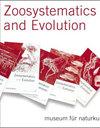Phylogenetic revision of Echinolaophonte Nicholls (Copepoda, Harpacticoida, Laophontidae T. Scott) including the establishment of two new genera and two new species
IF 0.9
2区 生物学
Q2 ZOOLOGY
引用次数: 0
Abstract
The record of a new species of Echinolaophonte Nicholls, 1941 (Copepoda, Harpacticoida, Laophontidae) from Jeju Island (Korea) formed the basis for a detailed and exhaustive phylogenetic revision of the genus. Comparison of all 15 species currently assigned to Echinolaophonte (including the new Korean species) revealed that its current composition cannot be maintained. The phylogenetic relationships within Echinolaophonte were elucidated through the analysis of 135 morphological characters and the inclusion of four outgroups. As a result, four species were removed from Echinolaophonte and placed in two new genera: Parechinolaophontegen. nov. for E. tropica Ummerkutty, 1970 and Pseudechinolaophontegen. nov. for E. minuta Cottarelli & Forniz, 1991, E. mordoganensis Kuru, Sönmez & Karaytug, 2019 and E. veniliae Cottarelli, Forniz & Bascherini, 1992. Echinolaophonte longantennata Apostolov, 1990 had to be excluded from the analysis, due to the fragmentary and imprecise description. Accordingly, the phylogenetic relationships of the ten species remaining in Echinolaophonte are clarified. The new Korean species is described as Echinolaophonte musasp. nov. Furthermore, the subspecies E. armiger f. briani Lang, 1965 is elevated to species rank as E. briani Lang, 1965. A detailed phylogenetic discussion is provided and a key to the species of Echinolaophonte is given.棘球蝽科(桡足目,棘球蝽科,棘球蝽科)的系统发育修正,包括2个新属和2个新种的建立
1941年在韩国济州岛发现的一新种Echinolaophonte Nicholls(桡足目,Harpacticoida, Laophontidae)为该属系统发育的详细修正奠定了基础。对目前属于棘孔虫的15种(包括韩国新种)的比较表明,棘孔虫的现有组成不能维持。通过对棘孔虫的135个形态特征和4个外类群的分析,阐明了棘孔虫的系统发育关系。结果表明,棘轮虫属中有4种被分离,并被归入两个新属:棘轮虫属。11 . E. tropica Ummerkutty, 1970和Pseudechinolaophontegen。11月,E. minuta Cottarelli & Forniz, 1991; E. mordoganensis Kuru, Sönmez & Karaytug, 2019; E. veniliae Cottarelli, Forniz & Bascherini, 1992。Echinolaophonte longantennata Apostolov, 1990由于描述不完整和不精确而被排除在分析之外。在此基础上,澄清了棘孔虫中剩余的10个种的系统发育关系。韩国新种为棘孔虫(Echinolaophonte musasp)。11 .此外,亚种E. armiger f. briani Lang, 1965被提升为E. briani Lang, 1965。对棘孔虫进行了详细的系统发育讨论,并给出了棘孔虫的种键。
本文章由计算机程序翻译,如有差异,请以英文原文为准。
求助全文
约1分钟内获得全文
求助全文
来源期刊

Zoosystematics and Evolution
ZOOLOGY-
CiteScore
3.50
自引率
5.00%
发文量
34
审稿时长
16 weeks
期刊介绍:
Zoosystematics and Evolution, formerly Mitteilungen aus dem Museum für Naturkunde in Berlin, is an international, open access, peer-reviewed life science journal devoted to whole-organism biology. It publishes original research and review articles in the field of Metazoan taxonomy, biosystematics, evolution, morphology, development and biogeography at all taxonomic levels. The journal''s scope encompasses primary information from collection-related research, taxonomic descriptions and discoveries, revisions, annotated type catalogues, aspects of the history of science, and contributions on new methods and principles of systematics. Articles whose main topic is ecology, functional anatomy, physiology, or ethology are only acceptable when of systematic or evolutionary relevance and perspective.
 求助内容:
求助内容: 应助结果提醒方式:
应助结果提醒方式:


